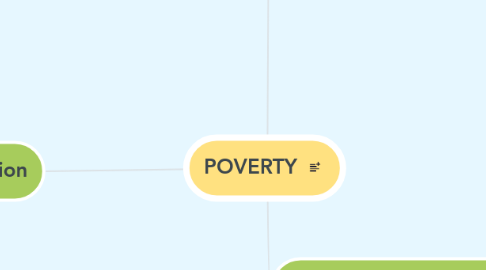
1. Criteria of a Poverty nation
1.1. HISTORY OF EXPLOITATION
1.1.1. Many poorest countries were previously slaved, ex: South Africa
1.1.2. Under Bristish/Dutch rule: restricted the rights of indigenous ppl in education, access to capital, land ownership; concentrate of wealth in white colonising minority racism
1.1.3. After 1994, poverty among indigenous population remained disproportionatedly high
1.1.4. Decolonisation in the 2nd half of 20th century left many nations (Sub-Saharan Africa) inadequate
1.2. WAR AND POLITICAL INSTABILITY
1.2.1. Conflict in Syria 2011 -> mass flow of millions of refugees seeking to escape, leaving behind a war-ton state that lacks the human+economic resources
1.2.2. 1990s in Somalia, instability still persists
1.3. STRUCTURAL ECONOMIC CONDITIONS
1.3.1. International economic order can either reinforce or ease poverty
1.3.2. WB, WTO often place developing countries at disadvantage
1.3.3. WB issues loans with certain condition (privatising public services like provision of h20, sanitation...) which have shown harm > good)
1.4. INEQUALITY
1.4.1. Reinforce what "haves" and "have nots" leading to a certain group of population lack the tool and resources to improve their situation
1.4.2. The state is unable to rescue its citizens because it lacks financial resources
1.4.3. Inequality is viewed at how much income a family has relative to the cost of living in that country
1.4.4. Eg: 16 million children in the US live in poverty which is different from children living in poverty in absolute in for example Congo
2. Definition & Types of poverty
2.1. DEFINITION
2.1.1. poverty begins with a consideration of conditions that prevent regions , states and peoples from having access to wealth
2.1.2. defined by WB as a "pronounced deprivation in well - being"
2.2. TYPES
2.2.1. Income or consumption poverty refers to a lack of monetary resources to meet needs
2.2.2. Absolute poverty is poverty below a set minimum needs for survival
2.2.3. Relative poverty is set in relation to others
2.2.4. Shelter poverty, food poverty, asset poverty, time poverty or health poverty refer to lack of that specific good
2.2.5. The transiently poor move in and out of poverty
2.2.6. Multidimensional poverty recognises the many different ways in which people can be deprived
2.2.7. The chronically poor are poor for years at a time, or even their whole lives
2.2.8. Vulnerability to poverty is the probability or risk of being in poverty or falling into poverty in the future
3. Measuring & reducing poverty
3.1. OFFICIAL DEVELOPMENT ASSISTANCE (AID)
3.1.1. Come from developed states / from 1 state to another or diverted multilaterally
3.1.2. Inappropriate types of aid can be sent: Gambia a number of oxygen devices were donated
3.1.3. Aid has been used for the political purposes of providing state: prop up, address poverty...
3.2. TRADE AND INVESTMENT
3.2.1. Free trade and reducing barriers to investment btw countries
3.2.2. Direct investment incorporates inconvenient reality since developing countries are involved in a minor way
3.3. MONEY LENDING
3.3.1. SDGs have been devised to be achieved in 2030, which apart from reducing poverty, address many conditions that feed and cement poverty conditions
3.3.2. Need to be paid back with interest
3.3.3. Many countries cannot afford due to the burden of their debt repayments. Although some debts have been cancelled the larger challenges caused by nature of outstanding loans and how they were imposed
3.4. UNITED NATION'S GOALS
3.4.1. MDGs: Millennium development goal
3.4.2. The initiative proved a mixed bag. Some goals related to education and child mortality have been improved while the rates of hunger and malnutrition have worsened
3.4.3. The financial crisis in 2008 has reduced the projected amount of money and jobs available to many government
